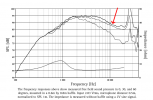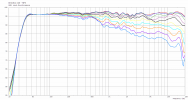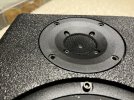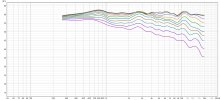This is description of the build of a Directiva speaker system I started last spring. I used the drivers and enclosure from the published Directiva build but deviated on the design of the crossover.
The system was intended for both home cinema and two channel music playback and will be used with four sealed twelve inch subs. I am using a Denon 4400h receiver with Apple TV and an Nvidia Shield as the source for video. For music I am using Roon, Tidal and Spotify on an iPad with airplay (and spotify connect) to send the audio to the receiver.
I use the receiver pre-outs to drive left, right and center Directiva speakers using two MinidspHDs for the crossovers (one for L &R and one for the C).
Amplification for the left and right channels uses an Adcom GFA-535 60 watt amp for the tweeter and a home built Hypex UCD180 for the Purifi woofers. The center Directiva uses a single stereo Adcom GFA-535 to drive both the Tweeters and the Woofers. The subs are two 12” Shiva in a sealed enclosure with 300 watt plate amps and two 12” CSS SDX 12 woofers in two sealed subs driven by an external Behringer NX3000 amp.

The speakers are painted with black duretex so that they are not visible when watching a movie. The placement of the left and right is unfortunately very close to the corners and the center is on the floor which is also not optimal. I use Audyssey MultEQ-X on PC to equalize the left and right to 500hz. I equalize the center to the full 20K. The subs are connected to a minidsp and equalized to be flat to 25Hz in room.
Here are a few shots of the Directiva build:

I used the parts express knock down cabinet kit and covered the interior with Kilmatt pads to add some extra mass to the enclosure to dampen resonances. I then lined with a blue jean derived acoustic insulation.

I went with sealed cabinets with a linkwitz transform to equalize to 40Hz since they will be crossed over at 80Hz by the Denon receiver to the 4 subs. I looked at the excursion at 80 Hz sealed and it should generate 106db at 80hz without exceeding its excursion limits.

Here is a picture of the completed speaker under test:

I used a minidsp Umik-1 usb mic and REW for measurements.
Rather than use the Directiva crossover, I used the technique of equalizing each driver to be flat within an octave of the crossover frequency and then applied a 24 db per octave Linkwitz-Riley filter for the cross over at 1.6 Khz. I went with a lower cross over frequency to try to better match the directivity of the tweeter with the woofer.
Left tweeter no eq:

Left tweeter with eq:

left woofer no eq:

Left woofer with eq 1K to 3K.

Left speaker with X-over at 1.6 Khz 24 db/octave linkwitz riley. Plus baffle step and Linkwitz base transform:

Ground plane without baffle step or Linkwitz transform



For the baffle step and linkwitz transform filter design, I imported the ground plane measurements into vituixCAD and adjusted the filters until I got the curve I wanted.
Following is the ground plane measurement with the filters installed in the minidsp.

The system was intended for both home cinema and two channel music playback and will be used with four sealed twelve inch subs. I am using a Denon 4400h receiver with Apple TV and an Nvidia Shield as the source for video. For music I am using Roon, Tidal and Spotify on an iPad with airplay (and spotify connect) to send the audio to the receiver.
I use the receiver pre-outs to drive left, right and center Directiva speakers using two MinidspHDs for the crossovers (one for L &R and one for the C).
Amplification for the left and right channels uses an Adcom GFA-535 60 watt amp for the tweeter and a home built Hypex UCD180 for the Purifi woofers. The center Directiva uses a single stereo Adcom GFA-535 to drive both the Tweeters and the Woofers. The subs are two 12” Shiva in a sealed enclosure with 300 watt plate amps and two 12” CSS SDX 12 woofers in two sealed subs driven by an external Behringer NX3000 amp.
The speakers are painted with black duretex so that they are not visible when watching a movie. The placement of the left and right is unfortunately very close to the corners and the center is on the floor which is also not optimal. I use Audyssey MultEQ-X on PC to equalize the left and right to 500hz. I equalize the center to the full 20K. The subs are connected to a minidsp and equalized to be flat to 25Hz in room.
Here are a few shots of the Directiva build:
I used the parts express knock down cabinet kit and covered the interior with Kilmatt pads to add some extra mass to the enclosure to dampen resonances. I then lined with a blue jean derived acoustic insulation.
I went with sealed cabinets with a linkwitz transform to equalize to 40Hz since they will be crossed over at 80Hz by the Denon receiver to the 4 subs. I looked at the excursion at 80 Hz sealed and it should generate 106db at 80hz without exceeding its excursion limits.
Here is a picture of the completed speaker under test:
I used a minidsp Umik-1 usb mic and REW for measurements.
Rather than use the Directiva crossover, I used the technique of equalizing each driver to be flat within an octave of the crossover frequency and then applied a 24 db per octave Linkwitz-Riley filter for the cross over at 1.6 Khz. I went with a lower cross over frequency to try to better match the directivity of the tweeter with the woofer.
Left tweeter no eq:
Left tweeter with eq:
left woofer no eq:
Left woofer with eq 1K to 3K.
Left speaker with X-over at 1.6 Khz 24 db/octave linkwitz riley. Plus baffle step and Linkwitz base transform:
Ground plane without baffle step or Linkwitz transform
For the baffle step and linkwitz transform filter design, I imported the ground plane measurements into vituixCAD and adjusted the filters until I got the curve I wanted.
Following is the ground plane measurement with the filters installed in the minidsp.






